products
GRP PIPES
GRP PIPES – WHAT IS SO SPECIAL ABOUT IT?
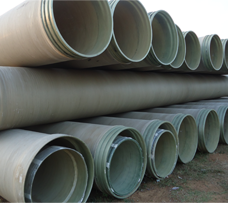 Water is fast depleting natural resource and mankind does not have the luxury of wasting it by transporting in open channels. Many countries have started recycling sewage and waste water and using it for human consumption. Water starved countries are using desalination to convert sea water to potable water.
Water is fast depleting natural resource and mankind does not have the luxury of wasting it by transporting in open channels. Many countries have started recycling sewage and waste water and using it for human consumption. Water starved countries are using desalination to convert sea water to potable water.
For conveying water, sewage, waste-water and sea water, the most cost effective solution is Glass fiber Reinforced Plastic (GRP) piping system.
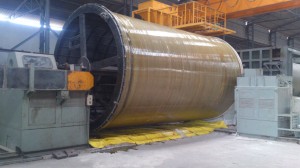
By virtue of its superior material characteristics, GRP pipes have become the ultimate choice replacing steel, DI and Concrete pipes for transporting different process fluids, sea water, raw water and potable water for different underground and aboveground applications.
The single most reason why people go for GRP is the total corrosion resistance that this material offers. Well-engineered GRP pipelines can be totally forgotten after installation for its life period without catholic protection or periodic maintenance and for this reason, GRP pipelines are called as “ZERO-MAINTENANCE PIPING”.
The prime advantages of GRP pipes are:
a) ABSOLUTELY CORROSION FREE: The material is inert to any type of water(sea water, raw water, potable water etc.) and for handling different process fluids, chemicals, acids , bases etc. With suitable GRP material system(resin), pipes can be designed for handling all fluids. M/s SSC will advise customers on this based on their requirement. No coating, gunniting, mortar lining or cathodic protection required with GRP piping.
b) SMOOTH INNER SURFACE: The inner surface of GRP pipe is the best among piping materials, due to which the friction loss is minimum with GRP pipes. Again, unlike steel and other materials, the smooth surface will remain the same throughout its intended service life, as the corrosion is absent in GRP. This gives less power consumption and low pumping cost throughout the pipeline life.
Hazen Williams Coefficient (“C” Value) for GRP is 150 for the purpose of design as per standards; however the tested values are in the range of 160-165. Because of higher ‘C’ Value, frictional losses in GRP Pipes are much less compared to that of conventional pipes. Hence, recurring energy charges and pump cost is lower in GRP Pipes compared to same diameter of other conventional pipes. Alternatively, we can reduce the diameter of GRP Pipes keeping frictional losses same as in case of conventional pipes.
c) LONGER LIFE: GRP pipes are designed for 50 years of life for normal applications. For Offshore applications, the design life is 20 years.
d) HIGH STRENGTH TO WEIGHT RATIO: The high-strength to weight ratio of this material offers the advantage of weight reduction and due to this, it is easy to handle & transport and this aids faster installation. It is light in weight, 1/5th of Steel, 1 /8th of CI and 1/10th of PSC for the same pressure rating and strength criterion.
e) EXCELLENT JOINT TIGHTNESS: Different joints like bell & spigot with rubber seal, coupler, butt & wrap flanged joints are available. Engineered joints totally eliminate ex-filtration / infiltration.
f) RESISTANCE TO SURGE PRESSURE: The water hammer in GRP pipe is less due to elasticity of GRP pipe. GRP pipes can withstand pressure up to 1.4 times of its pressure class in case of surge, which is higher than conventional pipes.
g) FREE OF MAINTENANCE: GRP pipelines are virtually maintenance free after installation. In case of repair, it can be repaired at site easily without any necessity of heavy equipments.
WHY GRP PIPES FROM SSC?
SSC’s radical design methodology, specific for composite materials and newer manufacturing technology combined with the economy of large-scale production have ensured that GRP Pipes are an economic alternative to conventional piping materials for water, sewage and sea-water application. If life-cycle and performance costs are compared, GRP Pipes will be 2 to 3 times cost effective than other piping system due to its superior properties.
Apart form the supply of GRP pipes to the process industries, SSC has converted many international water and sewage piping projects to GRP Piping systems. . SSC has completed the longest GRP piping project, the 27.5 miles (44.0 km.), 32 inch (800 mm) diameter, 175 psi (12 bar) effluent disposal pipeline. It has also designed, manufactured and installed the largest GRP Pressure pipe, 72 inches (1800mm), 75 psi (5 bar) and the highest pressure pipes, 600 psi (40 bar), 10 inch (250mm) diameter.
In addition, SSC establishes project specific manufacturing facilities on the basis of project economics and logistics. In fact, SSC is the pioneer in the conceptualization and adoption of project-specific manufacturing facilities in order to bring down the transportation cost of large diameter pipes. This scheme is being successfully adopted by SSC for large projects.
In addition to the supply GRP piping, SSC provides total engineering including the selection of composite material system for handling different corrosive media, installation and/or installation supervision. Our service covers the entire process of Design, Engineering, Manufacturing, Logistics and Installation.
GRP PIPES – APPLICATION
SSC designs and manufactures pipes for a wide range of applications:
Process pipes: These pipes are predominantly used for their corrosion resistant properties. These have been used for oveor 50 years in the chemical process industries like chloro-alkali, water treatment and paper bleaching. These pipes normally have high-end corrosion resistant resin system (Vinyl ester) with corrosion barrier thickness of 1.2 mm to 2.5 mm.
Water & Sewage pipes: Cost effective GRP pipes are replacing traditional materials like Ductile Iron, Pre-stressed Cement Concrete, Steel with epoxy coating / cement mortar lining, PV C and HDPE, which have been used for this application. GRP pipes offer a lower pumping cost and longer life due to its superior properties.
Fire Water piping: GRP pipes offer a better alternative to steel pipes for fire water lines. GRP pipes do not need wrapping & coating / cement mortar lining, PVC and HDPE, which have been used for this application. GRP pipes offer a lower pumping cost and longer life due to its superior properties.
Oil & Gas pipes: ASME Section 31.3 allows GRP pipes for all gas and oil pipelines.. Slowly, oil companies are accepting its use in produce water, process water and effluent water applications in on-shore oil fields and off-shore platforms.
Power Plant Piping: GRP piping are most suitable for sea water intake, sweet water intake, cooling water lines, DM water pipes, acid lines, condensate lines etc.
Product Range
SSC offers a wide range of piping products of various resin system and jointing options:
Diameter : 1 inch to 160 inches ( 25mm to 4000 mm)
Custom diameters can be manufactured
Length : Upto 40 feet ( 12 meters), Random lengths available
fittings
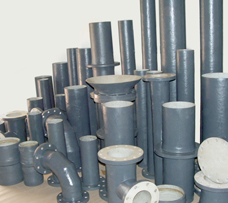 SSC has created a standardized line of GRP fittings that are molded or fabricated using the same materials that are used to produce GRP pipes. One of the benefits of GRP pipe is the ability to fabricate a wide assortment of fittings, standard as well as non- standard. The following are the category of standard GRP fittings. The dimensions can be obtained from the listing given in the SSC Fitting Catalogue.
SSC has created a standardized line of GRP fittings that are molded or fabricated using the same materials that are used to produce GRP pipes. One of the benefits of GRP pipe is the ability to fabricate a wide assortment of fittings, standard as well as non- standard. The following are the category of standard GRP fittings. The dimensions can be obtained from the listing given in the SSC Fitting Catalogue.
- ELBOWS & BENDS: Mitred / Moulded Construction
- TEES: Equal Tees & Unequal Tees
- REDUCERS: Concentric Reducers & Eccentric Reducers
- FLANGES : As per the requirement of client’s Drilling Std.
- END BLINDS: End Caps & Blind Flanges
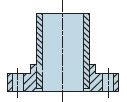
Flange

Saddle

Elbow 45

Elbow 90

Tee

Reducer

Coupling
Blind Flange
tanks and pressure vessels
FEATURES & ADVANTAGES OF FRP TANKS
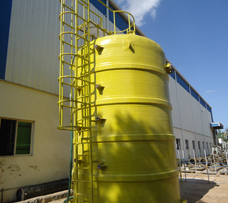
By virtue of its superior material characteristics, FRP TANKS have become the ultimate choice replacing steel tanks for storing different process fluids, chemicals, petroleum products, acids and water for various industrial applications.
FRP tanks are constructed as either vertical or horizontal types. Typically, vertical tanks are kept aboveground either on the floor or on supports and the horizontal tanks are kept over saddles for aboveground applications and buried under earth for underground applications.
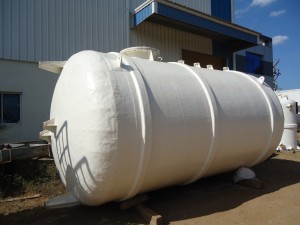
International Codes and specifications are available for FRP tank design, construction, testing and installation. All service requirements are met by the FRP tanks in total by suitable and appropriate design.
SSC also manufactures Thermoplastic Lined FRP tanks with thermoplastic liners such as PP, PVC, CPVC etc. based on chemical corrosion requirement.
The prime advantages of FRP tanks are:
Absolutely Corrosion- free
The material is inert to any type of water (sea water, raw water, potable water etc.) and for handling different process fluids, chemicals, acids, bases etc. With suitable FRP material system (resin), tanks can be designed for handling all fluids. M/s SSC will advise customers on this, based on their requirement.
The highly corrosion resistant materials ensure excellent performance and prevent contamination of stored materials.
Low Initial Cost
Fiberglass tanks cost considerably less than rubber lined, epoxy lined or stainless steel tanks of equivalent storage capacities.
Rugged fiberglass tanks are designed to provide long and trouble free service.
Easy to Install
Fiberglass tanks are approximately 1/4 the weight of steel tanks of equivalent storage capacity. Lighter, less expensive equipment is needed for installation.
Also, the installation costs are lower due to the requirements of smaller foundations and structural supports.
Low Maintenance
FRP tanks are virtually maintenance-free after installation. Simple washing with water is the periodic maintenance required for these tanks.
GOVERNING STANDARDS – FRP TANKS
| Standard | Description |
|---|---|
| BS 4994-87 | British Standard Specification for Design and Construction of Vessels and Tanks in Reinforced Plastics. |
| PS 15-69 | NBS Voluntary product standard |
| ASTM D 4097-88 | Standard Specification for Filament – wound Glass-Fiber – Reinforced Thermosetting Resin Chemical resistant Tanks |
| ASTM D 4021-92 | Standard Specification for Glass-Fiber–Reinforced Polyester Underground Petroleum Storage Tanks |
VERTICAL TANKS
Vertical fiberglass storage tanks are manufactured in different capacities as per customer requirement ranging from 100 litres to 100,000 littres. Vertical flat bottom tanks are designed for non pressure, non vacuum use. These tanks are available with open or closed top ends.
Vertical flat bottom tank should be installed on a base that can provide a continuous support and having sufficient strength to support the weight of the tank full of liquid with negligible deflection. For dished-bottom tank, a special support system is required.
Tanks are designed and manufactured with manhole, inlet, outlet and vent drain, hold down lugs and lift lugs as per requirement. External ladder and hand rails will be supplied upon client’s request.
SSC can supply standard vertical tanks for above ground applications from 600mm Diameter to 4000 mm Diameter.
HORIZONTAL ABOVEGROUND TANKS
FRP horizontal storage tanks for above ground application are available in different capacities as per client’s requirement. Tanks shall not be subjected to pressure nor vacuum (tanks must be vented). Vent opening shall be equal or larger than the maximum inlet or outlet size.
Each horizontal tank will include a manhole with cover, Inlet, Outlet and vent.
SSC can supply standard horizontal tanks for above ground applications from 600 mm Diameter to 4000 mm Diameter.
UNDERGROUND FUEL STORAGE
Fiberglass underground fuel storage tanks can be used to store gasoline, aviation fuel, gasohol (90% gasoline and 100% ethanol mixture), jet fuel, diesel fuel, potable water or waste water at ambient underground temperatures, or fuel oil at temperatures not to exceed 65°C.
Fiberglass tanks are strong enough to withstand constant traffic from the heaviest over the road vehicle.
Fiberglass underground tanks are designed to meet specific performance criteria in dry or fully flooded condition when properly installed.
All tanks must be vented, as tanks are designed for operation at atmospheric pressure only, except for use with vapour recovery systems provided the pressure or vacuum.
PRESSURE VESSELS AND SPECIALS
GRP SCRUBBERS, PRESSURE VESSELS and different types of Towers and GRP CASINGS for electro-chlorination plants are some of the speciality items manufactured by SSC in this category.
Specialty Piping
<
The individual form and size of each Non Circular pipeline is defined by the client and project specifications as well as in regard to hydraulic, static and chemical requirements.
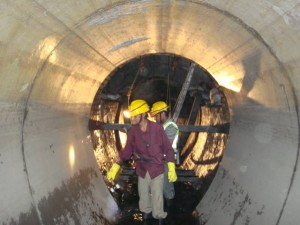
A distinctive feature of the SSC Non Circular Pipe Products is their high strength and highly resinous inner pipe layer. Once this layer is applied onto the individually manufactured mandrel (form), the actual winding process for building the wall begins and is finalized with an external sturdy sand-filled protective layer.
Product Range
As per Client Specifications.
Product Application
Rehabilitation of Trunk Sewers
fdgfdf ffdfd fddfd


